This article addresses the popularity of Queen Anne furniture in America in the first half of the 18th century, noting the major differences in design between the American and English styles. It originally appeared in the October 1939 issue of American Collector magazine, a publication which ran from 1933-1948 and served antique collectors and dealers.
Whole books, and many of them, have been written about American furniture of various periods and special localities but one of the most charming styles has had scant attention. This bears the name of Queen Anne, England’s last Stuart monarch.
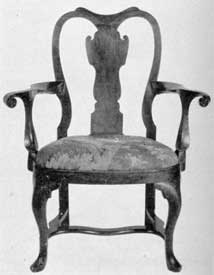
A Philadelphia Armchair: This is a typical example of the fine work done by Philadelphia cabinetmakers. Made of walnut, the shaping of the seat, back, legs, and bold curve of the arms show the Queen Anne style in its most elaborate manner.
There this furniture period began with her accession to the throne, in 1702, and continued after her death, in 1714, with decreasing influences through the years known collectively as Early Georgian, until the advent of the Chippendale style. This, for the sake of chronology, can be set down as 1754, the year when Thomas Chippendale’s book, The Gentleman and Cabinet-Maker’s Director was published in London for and by this enterprising cabinetmaker of St. Martin’s Lane.
In America, the Queen Anne style did not get its hold on the popular taste until the monarch whose name it bore was dead and the first of the Hanoverian Georges was nearly half through his reign. But it continued in favor right up to the time when the impact of Chippendale designs made themselves felt in American furniture craftsmanship. One must, of necessity, be a little vague as to the years of the Queen Anne style. About 1720 to 1760 is a fair estimate.
It was a propitious period. Although there was widespread inflation in the paper currencies, which the various colonies issued with cheerful unconcern as to specie reserve, the people were prosperous. The Treaty of Utrecht, which concluded the War of the Spanish Succession that had all but torn Europe asunder, had initiated an era in the American colonies of unprecedented business prosperity.

New England Maple Highboy: With bonnet top, fan-carved drawer fronts, finials and scalloped apron, this is a typical example of the design during the latter part of the period.
The 17th-Century coastal settlements and those further inland were now well-established communities with a smoothly functioning domestic economy and the coastwise and transatlantic commerce of the seaport towns was large and highly profitable. True, there were certain Acts of Trade prohibiting American ships from taking part in international trade, but shrewd merchant shipowners, like Peter Fanuiel, knew how to get around the letter of the law by misleading custom officials or even smuggling.
Also a new type of American ship, the schooner, had been originated at Gloucester, Massachusetts, in 1713, by Abraham Robinson. It could carry cargoes faster and with a smaller crew than had been possible before. Although it may seem far-fetched, I believe there is a distinct relationship between American Queen Anne furniture and the schooner.
The colonies were producing more farm and forest products than they could consume. The quick and economically operated schooners, built for from £12 to £15 a ton, took this excess production to foreign ports where good markets were waiting. Profits from this sea-borne trade were ample to offset the dangers of an inflated paper currency, and so the American colonists could spend money to improve and augment their household furnishings.
This explains the quantities of furniture in the new style which were fashioned from Pennsylvania northward to Massachusetts and New Hampshire. Also the majority of craftsmen producing it were native-born. So their designs did not directly copy those of England. They had a certain individuality that makes it easy to distinguish American Queen Anne from that of England.

A New England Tea Table: Made of mahogany, with its molded top, clover leaf corners, slender cabriole legs and Dutch feet, this is a very graceful design delicately executed.
The American pieces have distinct grace but they are less ornate. It was during this period that the native woods came into their own. Study a hundred representative examples of our antique furniture made during these years and you will find that the predominating woods are walnut, maple, cherry and occasionally pine for primitive pieces made in isolated farming regions. Rarely do you discover one of mahogany. And when found, it has the details that mark the transition from Queen Anne to Chippendale.
At the same time, these American Queen Anne examples mark a sharp cleavage from both the preceding William and Mary period and the sturdy but somewhat heavy 17th-Century furniture, Tudor-like in its construction of panels, stiles and rails. There was grace, lightness, and delicacy of detail, which struck a new note in our furniture.
First, there was the cabriole leg terminating with either a plain, well-shaped Dutch foot or the carved webfoot, so-called for its remote resemblance to that of the barnyard waterfowl. Variations of this leg and foot were used on chairs, tables, beds, day beds, desks, chests on frames, highboys and lowboys. In fact, the majority of Queen Anne pieces had this pleasing detail, although there were a few simple ones made with turned legs and button feet. In chairmaking, also, there was one other type of design that was very popular. This was the chair with turned front legs terminating in carved Flemish scrolls known as the Spanish foot.

Cherry Chest on Frame: The flat cornice molding and sunburst carvings are characteristic of the earlier work of the Queen Anne period, particularly in New England.
In fact, as the Queen Anne period progressed, the chair became more and more skillfully designed and made. Instead of a straight-lined seat a curved one, wider at the front than at the back, came into vogue. The back with its vase-shaped central splat and crested and carved top was given an added vertical curve which made for both beauty and comfort.
But perhaps the high point of Queen Anne furniture was reached in the highboy, the lowboy, and the tea table with molded top. These were also the background from which later came the elaborate pieces of the same sort liberally decorated with fine carving in the Chippendale period, which were without doubt the most beautiful ever made by American cabinetmakers.
The earlier Queen Anne highboys in America had simple cabriole legs and Dutch feet, a lower section with two tiers of drawers and front or skirt cut at the bottom in pleasing curves to form a valance shaping. Sometimes pendent finials were placed at two low points on this valance which divided the spacing from leg to leg equally and were in relation to the placing of the drawers above.
The upper section of highboys with either five or six drawers was structurally simple and of right angle lines. A straight cornice molding not too complicated in its elements but still bold enough to give decorative emphasis was applied to front and sides. The next step in giving such a piece an added touch of decoration was a fan or sunburst carving. Sometimes this treatment was applied to the front of a central drawer in the lower section. At others, it was also used for a drawer front of like shape in the center of the upper tier of the top section.

A Small Desk on Frame: New England pieces in walnut of small size are much more unusual than those of standard dimensions.
Since highboys and lowboys of matching design were frequently made during both the Queen Anne and Chippendale periods, the lowboy generally followed the highboy in structure and design with the exception that its dimensions were smaller. As the Queen Anne period progressed, both pieces were made more decorative. Shell carvings, sometimes finished with gold leaf, replaced the fans or half sunbursts. Toward the close of the period some remarkably fine highboys were made with a beautifully executed broken pediment bonnet top. Here the decorative value was further enhanced by the logical use of a central and two corner finials. These were usually of the spiral turned design, now known as flame finials.
Many New England highboys and lowboys were made of maple. Sometimes the drawer fronts were of carefully selected curly grain. A few, probably made during the last decade, were of mahogany. In Pennsylvania, the wood used for these pieces, as with all other furniture of the Queen Anne era, was nearly always the fine rich red walnut that was then so plentiful. Occasionally mahogany was also used in this section for elaborate pieces.
As for tables, although the gate-leg of William and Mary origin continued to be popular because of its sturdy practicality, those with cabriole legs were widely made. They were by no means the banquet boards of later times, but rather small tables with drop leaves. The tops were either square, oblong, oval, or circular. We think of them as tea tables but they were probably the dining tables of the time, since the elders and children of a family did not eat together. Father was too august a person to have his repasts intruded on by the junior members of his household.
Further, the custom of drinking Chinese tea was just appearing on the American horizon, together with delicate cups and plates of porcelain from the same far away country. To meet this new fashion, the American cabinetmakers evolved a most beautiful piece. It was the oblong tea table without leaves in which the top was surrounded with a raised molding. It was practical as well as decorative since it guarded the precious china from being accidentally brushed to the floor and broken.

A Queen Anne Day Bed: The double splat of the back, shell carvings on the knees of legs, and cresting of the top, are characteristic details with the elaborate work of the period. Of Philadelphia origin, it was made of mahogany.
Such tables invariably had delicate cabriole legs and Dutch feet. Also, the skirt or apron beneath the top was always cut with a pleasing combination of cyma, curves on the lower edge to give finish and add decoration. These pieces are by no means common; and, when found, are either made of walnut of the finest quality or of mahogany, suggesting that they were made during the closing years of the Queen Anne period. Also, most of those which I have seen were made in New England, a circumstance that suggests the tea party may have been more popular north of New York than south of it.
There were, of course, other pieces made in the American Queen Anne manner. Among them was the desk with slant top and cabriole legs, or an upper section resting on a frame of like design; the chest on frame and, occasionally, the chest on chest. But their treatment as regards structure and design was the same as the pieces that have been discussed in detail. They all had the outstanding characteristic of the Queen Anne as expressed by American cabinetmakers, grace that comes from a wise use of pleasing curves when structurally logical. They avoided the sin of using curved lines where straight ones would suit the purpose of structure and design better. In fact, the cabinetmakers who made this furniture knew something that others in foreign lands, and some who worked later in America, never understood — that too many curves could spoil a product.
In England, Queen Anne furniture, as might be expected, was more elaborate in both design and ornamentation. Even then it retained the same feeling of grace and directness that characterized what was made in America, despite the carved decorations that the English cabinetmakers of the period used whenever possible.
This article originally appeared in American Collector magazine, a publication which ran from 1933-1948 and served antique collectors and dealers.
 Marilyn Monroe's Naked Attempt to Outshine Elizabeth Taylor
Marilyn Monroe's Naked Attempt to Outshine Elizabeth Taylor Too Lazy To Work Out? Machines That Exercise for You, From Victorian Era to Now
Too Lazy To Work Out? Machines That Exercise for You, From Victorian Era to Now Good Girls and Bad Boys: How to Achieve That Cool '50s Rockabilly Look
Good Girls and Bad Boys: How to Achieve That Cool '50s Rockabilly Look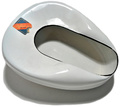 World's Foremost Bedpan Collector Celebrates Objects Most People Pooh-Pooh
World's Foremost Bedpan Collector Celebrates Objects Most People Pooh-Pooh Postcards From Big Brother: The Curious Propaganda of a Brutal Soviet Era
Postcards From Big Brother: The Curious Propaganda of a Brutal Soviet Era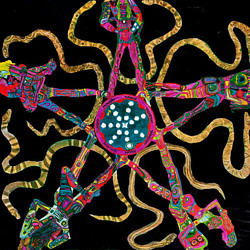 Mari Tepper: Laying it on the Line
Mari Tepper: Laying it on the Line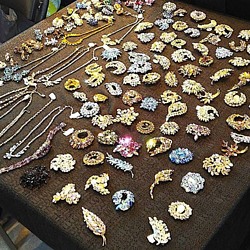 Nice Ice: Valerie Hammond on the Genteel Charm of Vintage Canadian Costume Jewelry
Nice Ice: Valerie Hammond on the Genteel Charm of Vintage Canadian Costume Jewelry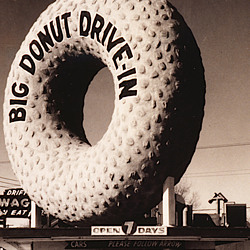 How Jim Heimann Got Crazy for California Architecture
How Jim Heimann Got Crazy for California Architecture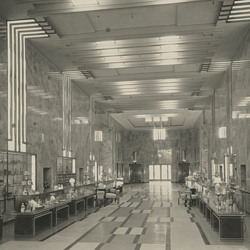 Modernist Man: Jock Peters May Be the Most Influential Architect You've Never Heard Of
Modernist Man: Jock Peters May Be the Most Influential Architect You've Never Heard Of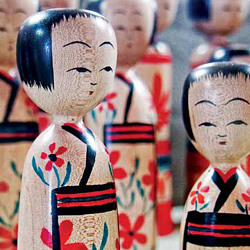 Meet Cute: Were Kokeshi Dolls the Models for Hello Kitty, Pokemon, and Be@rbrick?
Meet Cute: Were Kokeshi Dolls the Models for Hello Kitty, Pokemon, and Be@rbrick? When the King of Comedy Posters Set His Surreal Sights on the World of Rock 'n' Roll
When the King of Comedy Posters Set His Surreal Sights on the World of Rock 'n' Roll How One Artist Makes New Art From Old Coloring Books and Found Photos
How One Artist Makes New Art From Old Coloring Books and Found Photos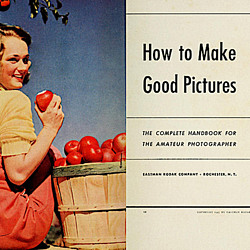 Say Cheese! How Bad Photography Has Changed Our Definition of Good Pictures
Say Cheese! How Bad Photography Has Changed Our Definition of Good Pictures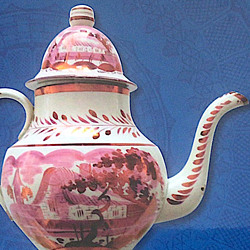 Middle Earthenware: One Family's Quest to Reclaim Its Place in British Pottery History
Middle Earthenware: One Family's Quest to Reclaim Its Place in British Pottery History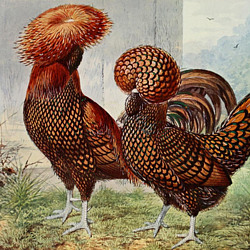 Fancy Fowl: How an Evil Sea Captain and a Beloved Queen Made the World Crave KFC
Fancy Fowl: How an Evil Sea Captain and a Beloved Queen Made the World Crave KFC
I am a docent at Mount Harmon Plantation, whose 18th century manor house was restored and furnished in period antiques by Marguerite du Pont de villiers Boden. Thank you for this wonderful article, which helps me understand and appreciate the beauty of the Queen Anne pieces Mrs. Boden placed in her home.
Barbara Garner
http://www.mountharmon.org